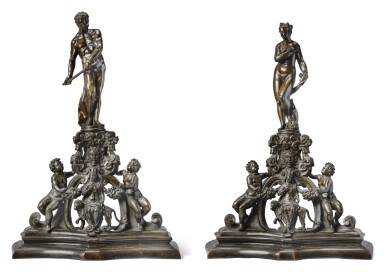Master Sculpture and Works of Art Part II
Master Sculpture and Works of Art Part II

Property from a Distinguished Private Collection, Washington, D.C.
Workshop of Girolamo Campagna (Verona 1549–1625 Venice) Venice, early 17th century
Firedogs with Vulcan and Venus Marina: a pair
Lot Closed
January 30, 07:46 PM GMT
Estimate
50,000 - 80,000 USD
Lot Details
Description
Workshop of Girolamo Campagna
(Verona 1549–1625 Venice)
Venice, early 17th century
Firedogs with Vulcan and Venus Marina: a pair
bronze, with modern steel stands
heights 34 3/4 in.; 88.3cm.
From whom acquired, 1994
Andirons or firedogs are a pair of metal supports for firewood which can placed in a hearth. A horizontal iron bar extends into the fire to support the wood, with vertical bronze supports at the front to prevent the logs falling forward. During the 16th and 17th century, particularly in Venice, these vertical supports became more elaborate with allegorical figures, often related to the element of Fire. Andirons were produced, like many other functional bronze objects such oil lamps, inkwells and candlesticks, by a vibrant community of foundries and artists based in and around La Serenissima. Peta Motture’s illuminating study, presented at the 1999 Washington symposium Large Bronzes in the Renaissance, explored the complex and poorly documented relationship between the leading sculptors and the foundries. A few andirons are signed, such as a pair in the Victoria and Albert Museum signed by Giuseppe de Levis, whilst others are initialed. However, it is more often than not impossible to securely attribute individual pairs of andirons.
The present impressive pair of andirons perfectly illustrates the central issues involved in the connoisseurship in this field. The quality of these bronzes is excellent. The design is bold and sculptural. Vulcan and Venus Marina stand in elegant contrapposto surmounting a base centered with a grotesque mask flanked by bifurcated sirens, above an allegorical female figure seated on a pacing lion in between two nude putti holding festoons and looking up. The iconography is original and seems to relate to archetypal Venetian aspirations, which has led some to associate them with a commission from the City of Venice itself, seeing the crowned allegorical woman on the lion as emblematic of Venice and proposing that the figure of Vulcan would be appropriate for an office in the Venetian Zecca (the mint), or the Arsenal (the Venetian wharf), see Laverack, op. cit., p. 89.
These andirons were attributed to Tiziano Aspetti in 1993, guided by Leo Planiscig’s attribution of the model of the Venus Marina to this sculptor. Weihrauch, however, attributed a version of the Venus, initialed I.C. in the Goldschmidt Collection, Berlin, to Girolamo Campagna which calls into question a definitive attribution for these andirons. Motture explains that the nature of the production of andirons in Venice around 1600 meant that foundries could often interchange different elements depending on the particular commission and certain elements in the design could be copied or reinterpreted. Since andirons are constructed from many sections bolted together, these could be easily interchanged according to taste or the financial means of the patron.
The crisp casting of Vulcan’s hair, the fine tiara worn by Venus and the strong modelling of the anatomy in both mythological figures and the putti below testify to the hand of a leading sculptor in early 17th century Venice. The iconography is certainly appropriate for a sophisticated Venetian nobleman, or even a State commission, but as with the majority of andirons now divorced from their original settings their true context and author remain unknown.
RELATED LITERATURE
L. Planiscig, Venezianische Bildhauer, Vienna, 1921, pp.582-3;
H.R.Weihrauch, Europäische Bronzestatuetten, 15-18 Jahrhunderts, Brunswick, 1967, pp.156-157;
W. Bode (J. Draper rev.ed.), The Italian bronze statuettes of the Renaissance, 1980, pl. CLVIII;
P. Motture, ‘The Production of Firedogs in Renaissance Venice’, in P. Motture (ed.), Large Bronzes in the Renaissance, New Haven and London, 2003, pp. 277-307
